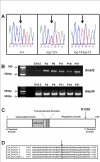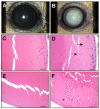A spontaneous mutation in Srebf2 leads to cataracts and persistent skin wounds in the lens opacity 13 (lop13) mouse
- PMID: 21858719
- PMCID: PMC3251904
- DOI: 10.1007/s00335-011-9354-2
A spontaneous mutation in Srebf2 leads to cataracts and persistent skin wounds in the lens opacity 13 (lop13) mouse
Abstract
Lens opacity 13 (lop13) is a spontaneous, autosomal recessive mouse mutant that exhibits nuclear cataracts. Histological analysis revealed swollen lens fiber cells and the presence of bladder cells within the lens cortex, as well as morgagnian globules and liquefied material at the lens posterior. At 3 months of age, in addition to cataracts, lop13 mice also develop persistent skin wounds. Linkage analysis assigned the lop13 locus to a 1.1-Mb region on mouse Chr 15, encompassing 19 candidate genes. Sequence analysis identified a C3112T mutation in exon 18 of Sterol Regulatory Element Binding-Transcription Factor 2 (Srebf2) resulting in the R1038C substitution of a highly conserved arginine within the Srebf2 regulatory domain. Srebf2 belongs to a family of membrane-bound basic helix-loop-helix leucine zipper transcription factors that control the expression of genes involved in the biosynthesis and uptake of cholesterol and fatty acids. The lack of complementation observed in Srebf2 ( lop13/GT ) compound heterozygotes carrying the Srebf2 gene trapped allele (Srebf2 ( GT )) provides genetic evidence that the identified C3112T substitution in Srebf2 is responsible for the lop13 phenotype. Gas chromatography analysis identified lower levels of cholesterol in the lop13 brain, liver, and lens when compared to wild-type mice. These findings suggest that lop13 is a hypomorphic mutation in Srebf2. As such, the lop13 mouse presents an invaluable in vivo model for studying the contribution of Srebf2 and cholesterol to maintaining the homeostasis of the lens and skin.
References
-
- Abraham AG, Condon NG, Gower E West. The new epidemiology of cataract. Ophthalmol Clin North Am. 2006;19:415–425. - PubMed
-
- Broeckling CD, Reddy IR, Duran AL, Zhao X, Sumner LW. MET-IDEA: data extraction tool for mass spectrometry-based metabolomics. Anal Chem. 2006;78:4334–4341. - PubMed
-
- Cenedella RJ. Source of cholesterol for the ocular lens, studied with U18666A: a cataract-producing inhibitor of lipid metabolism. Exp Eye Res. 1983;37:33–43. - PubMed
-
- Cenedella RJ. Cholesterol and cataracts. Surv Ophthalmol. 1996;40:320–337. - PubMed
Publication types
MeSH terms
Substances
Grants and funding
LinkOut - more resources
Full Text Sources
Medical
Molecular Biology Databases
Research Materials
Miscellaneous








